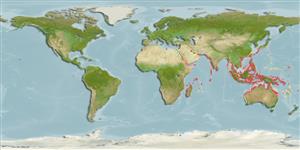Common names from other countries
Environment: milieu / climate zone / depth range / distribution range
Ecology
Marine; freshwater; brackish; reef-associated; depth range ? - 10 m (Ref. 86942). Tropical; 36°N - 35°S, 20°E - 168°E
Indo-West Pacific: East Africa, Madagascar, Seychelles, Red Sea, Arabian Peninsula, Persian Gulf to India and Andaman Islands; and southeast Asia. Reaches south to the Arafura Sea (Ref. 9819) and northern Australia (Ref. 3131).
Size / Weight / Age
Maturity: Lm ? range ? - ? cm
Max length : 30.0 cm SL male/unsexed; (Ref. 4327)
Dorsal spines (total): 11 - 12; Dorsal soft rays (total): 9 - 11; Anal spines: 3; Anal soft rays: 7 - 9. Body oval, compressed, robust. Lower opercular spine extending well beyond the opercular flap. Post-temporal bone exposed posteriorly and serrate. Color is dusky green above, white below; body, head and fins with an iridescent sheen. Four longitudinal brown stripes extend on the upper side from the head. A large prominent black blotch is on the distal end of the spinous portion of the dorsal fin. Similar brown stripes run across the caudal fin. (from Ref. 3131).
Adults inhabit coastal waters (Ref. 5213). Often found in brackish waters (Ref. 4833). Juveniles with floating weeds, often far offshore (Ref. 48635). Eggs are guarded and fanned by the male parent (Ref. 205). Marketed fresh (Ref. 5284).
Life cycle and mating behavior
Maturities | Reproduction | Spawnings | Egg(s) | Fecundities | Larvae
Eggs are guarded and fanned by the male parent (Ref. 205).
Paxton, J.R., D.F. Hoese, G.R. Allen and J.E. Hanley, 1989. Pisces. Petromyzontidae to Carangidae. Zoological Catalogue of Australia, Vol. 7. Australian Government Publishing Service, Canberra, 665 p. (Ref. 7300)
IUCN Red List Status (Ref. 130435)
CITES (Ref. 128078)
Not Evaluated
Threat to humans
Harmless
Human uses
Fisheries: minor commercial
Tools
Special reports
Download XML
Internet sources
Estimates based on models
Preferred temperature (Ref.
115969): 24.9 - 29.3, mean 28.5 (based on 3179 cells).
Phylogenetic diversity index (Ref.
82804): PD
50 = 0.6250 [Uniqueness, from 0.5 = low to 2.0 = high].
Bayesian length-weight: a=0.01122 (0.00683 - 0.01843), b=3.04 (2.90 - 3.18), in cm Total Length, based on LWR estimates for this species & (Sub)family-body (Ref.
93245).
Trophic level (Ref.
69278): 3.7 ±0.46 se; based on food items.
Resilience (Ref.
120179): High, minimum population doubling time less than 15 months (K=0.6-0.8).
Fishing Vulnerability (Ref.
59153): Low vulnerability (24 of 100).
